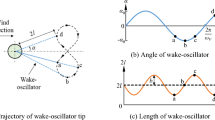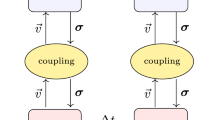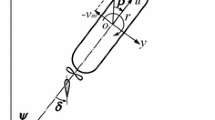Abstract
The patterns of wing rock motion at 52.5° angle of attack have already been investigated in detail (Rong, 2009; Wang, 2010). These patterns are completely different from those at other angles of attack. This phenomenon indicates that angle of attack affects wing rock motion. The present study aims to examine the different patterns of wing rock motion at different angles of attack. The flow mechanisms of the motion patterns are also revealed, especially the uncommanded lateral motions, including wing rock and lateral deflection, induced by regular asymmetric separated flow from wings at low angles of attack and forebody asymmetric vortices at angles of attack of 27.5°⩽ α ⩽ 70°. The test conditions, including the testing Reynolds number, wind tunnel, experimental techniques, and test model, are all the same as those used in a previous study at α = 52.5°. Finally, the experimental technique of rotating nose of the model to suppress the wing rock or lateral deflection, which is induced by forebody asymmetric vortex flow, is applied. The uncommanded lateral motions are successfully suppressed by this technique.
Similar content being viewed by others
References
Katz J. Wing/vortex interactions and wing rock. Prog Aerosp Sci, 1999, 35: 727–750
Nelson R C, Pelletier A. The unsteady aerodynamics of slender wings and aircraft undergoing large amplitude maneuvers. Prog Aerosp Sci, 2003, 39: 185–248
Brandon J M, Nguyen L T. Experimental study of effects of forebody geometry on high angle of attack stability. J Aircraft, 1988, 25: 591–597
Fratello D J, Croom M A, Nguyen L T, et al. Use of updated NASA langley radio-controlled drop-model technique for high-alpha studies of the X-29A configuration. AIAA Paper, 1987, AIAA-87-2559
Quast T, Nelson R C, Fisher D F. A study of high alpha dynamics and flow visualization for a 2.5% model of the F-18 HARV undergoing wing rock. AIAA Paper, 1991, AIAA-91-3267
Klein V, Noderer K D. Aerodynamic parameters of the X-31 drop model estimated from flight data at high angles of attack. AIAA Paper, 1992, AIAA-92-4357
Ericsson L E. Further analysis of wing rock generated by forebody vortices. J Aircraft, 1989, 26: 1098–1104
Ma B F. Experimental Investigation of Roll Oscillation Induced by Forebody Vortex. Post Doctor Report. Beijing: Beijing University of Aeronautics and Astronautics, 2007
Rong Z. An Experimental Investigation on Flow Characteristics and Mechanism of Wing Rock Induced by Forebody Vortex. Dissertation for Doctoral Degree. Beijing: Beijing University of Aeronautics and Astronautics, 2009
Wang B. The study on Reynolds Number Effect of Wing Rock Induced by Forebody Vortex. Dissertation for Doctoral Degree. Beijing: Beijing University of Aeronautics and Astronautics, 2010
Wang B, Deng X Y, Ma B F. Effect of tip perturbation and wing locations on rolling oscillation induced by forebody vortices. Acta Mech Sin, 2010, 26: 787–791
Moskovitz C A, Raleigh N C, Hall R M. Effects of surface perturbations on the asymmetric vortex flow over a slender body. AIAA Paper, 1988, AIAA-88-0483
Moskovitz C A, Hal R M, Dejarnette F R. Effects of nose bluntness, roughness and surface perturbations on the asymmetric flow past slender bodies at large angles of attack. AIAA Paper, 1989, AIAA-89-2236
Zilliac G G, Degani D, Tobak M. Asymmetric vortices on a slender body of revolution. AIAA J, 1991, 29(5): 667–675
Chen X R, Deng X Y, Wang Y K. Influence of nose perturbations on behaviors of asymmetric vortices over slender body. Acta Mech Sin, 2002, 18(6): 581–593
Deng X Y, Wang G, Chen X R. A Physical model of asymmetric vortices flow structure in regular state over slender body at high angle of attack. Sci China Ser E-Tech Sci, 2003, 46: 561–573
Alcorn C W, Croom M A, Francis M S, et al. The X-31 aircraft: Advances in aircraft agility and performance. Prog Aerosp Sci, 1996, 32: 377–413
Zhang J. Research of Control Method and Mechanism of Fore Body Vortices Induced Wing Rock. Dissertation for the Master Degree. Beijing: Beijing University of Aeronautics and Astronautics, 2010
Author information
Authors and Affiliations
Corresponding author
Rights and permissions
About this article
Cite this article
Xu, S., Deng, X. Effects of angle of attack on wing rock motion induced by the flows over slender body with low swept wing. Sci. China Phys. Mech. Astron. 58, 1–8 (2015). https://doi.org/10.1007/s11433-014-5630-y
Received:
Accepted:
Published:
Issue Date:
DOI: https://doi.org/10.1007/s11433-014-5630-y




